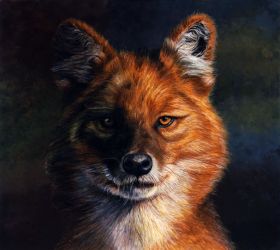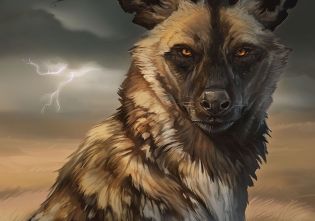Difference between revisions of "Dog (wild)"
Tao alexis (talk | contribs) |
Tao alexis (talk | contribs) |
||
| (10 intermediate revisions by the same user not shown) | |||
| Line 29: | Line 29: | ||
| '''[[Hit Points per Die|Hp/Die]]''' || d3 (d4) || d4 (d6) | | '''[[Hit Points per Die|Hp/Die]]''' || d3 (d4) || d4 (d6) | ||
|- | |- | ||
| − | | ''' | + | | '''Attacks''' || colspan="2"|'''1''': [[Fangs (attack)|fangs]] |
|- | |- | ||
| '''[[Damage (hit points)|Damage]]''' || 1-4 || 1-6 | | '''[[Damage (hit points)|Damage]]''' || 1-4 || 1-6 | ||
| Line 36: | Line 36: | ||
|} | |} | ||
| − | '''Wild Dog''' is a term broadly applied to canines that are either African in origin ("wild African dog") or Asiatic ("dhole"). Dogs that are feral, meaning formerly domesticated who have reverted to the wild, should be treated as [[Dog (domestic)|domestic dogs]]. | + | '''Wild Dog''' is a term broadly applied to canines that are either African in origin ("wild African dog") or Asiatic ("dhole"). Dogs that are [[Feral|feral]], meaning formerly domesticated who have reverted to the wild, should be treated as [[Dog (domestic)|domestic dogs]]. |
== Dhole == | == Dhole == | ||
| − | The '''dhole''' are the smaller of the two, being "cat-like" on account of its long backbone and slender limbs. It has a wide skull and is | + | [[File:Dhole.jpg|left|280px|thumb|'''Dhole''']] |
| + | The '''dhole''' are the smaller of the two, being "cat-like" on account of its long backbone and slender limbs. It has a wide skull and is the more intelligent species. The general tone of fur is reddish, which grows dull in winter or rainy months. The dhole are common in both the lowlands and highlands of Central Asia, Tibet, Mongolia and India, reaching as far east as Korea. Dhole cannot be tamed. | ||
| − | + | They are highly social. They live in a simple earth den, which they steal from other creatures or re-use from earlier migrations. As a pack, they have no dominance rituals. The dhole hunt in groups of 3-5 animals, joining together during reproduction or during migrations. | |
| − | They are highly social. They | + | |
| + | The dhole aren't territorial; instead, they migrate hundreds of miles in search of new habitats. During migration they'll lose several pounds from starvation, causing them to engage and hunt aggressively on resettling, chasing their prey for a dozen hours when hungry. A famous legend tells of numbers of dhole treeing tigers and keeping them there until the tiger tires and falls prey. | ||
| − | Some villagers welcome the return of the dhole because | + | Sometimes, the dhole will "overhunt," during resettlement, killing more than they eat. Some villagers welcome the return of the dhole because this gives an opportunity for easy meat. |
| − | === Throat Attack === | + | ==== Throat Attack ==== |
| − | When a dhole rolls a [[Critical Hits & Fumbles|natural d20]], it's | + | When a dhole rolls a [[Critical Hits & Fumbles|natural d20]], it's understood that the dhole has [[Attacking in Combat|attacked]] the target's throat. Therefore, critical hits made by the dhole cause '''triple''' [[Damage (hit points)|damage]], not double. As with any natural 20, the dice are rolled again, with progressive 20s increasing the damage to quadruple, quintuple, sextuple and so on. Natural 19s do not increase damage with dhole attacks. |
<br> | <br> | ||
== Wild African Dog == | == Wild African Dog == | ||
| − | [[File:Wild Dog.jpg|left| | + | [[File:Wild Dog.jpg|left|315px|thumb|'''Alison Theus''' (artist); a wild African dog]] |
| + | The African dog is solidly built, comparatively lean, tall dog with outsized ears and lacking dewclaws. The skull is short and broad, while the body is covered by stiff bristle-hairs; there's no underfur. The animal loses its fur as it ages, so the cleverness of a given dog can be recognized by those with experience. | ||
| + | |||
| + | Colour variation is extreme. Black with small white and yellow patches is common in the north, while southern African wild dogs are a mix of brown, black and white. The wild dog is found throughout south and east Africa, as well as the [[Sahel (savanna)|Sahel]]; a small number have been released in the southwestern corner of the [[Arabia|Arabian Peninsula]]. | ||
| + | |||
| + | African dogs have strong social ties, with a high ratio of males to females. There isn't a fixed breeding season. The wild dog is a specialised pack hunter of medium-sized hoofed animals, hunting by approaching prey silently and then chasing it with phenomenal speed. In hunting, packs are organized so that different groups can strike the prey by surprise, from different flanks. Beasts as large as wildebeest and wild boars are hunted ... but gazelles and antelopes are preferred. Wild dogs will chase prey, wearing it down for hours if need be, until it's tired enough to give in without a fight. | ||
| + | |||
| + | [[Lion|Lions]] are the chief competitor of these African dogs. Wild dogs killed by lions are left uneaten. [[Hyena|Spotted hyenas]] are known to follow packs of wild dogs to appropriate their kills. Apart from lions, African dogs are apex predators, rarely losing fights to larger social carnivores. | ||
| + | |||
| + | Wild African dogs are also able to employ the dhole's [[Dog (wild)#Throat Attack|throat attack]]. | ||
| + | |||
| + | |||
See [[Bestiary]] | See [[Bestiary]] | ||
| − | [[Category: | + | [[Category: Don't Review until 2022]] |
Latest revision as of 16:54, 17 June 2022
| Type | Dhole | Wild African Dog |
| Species | canine | |
| No. Appearing | 5-20 | 4-24 |
| Behaviour | social (clan) | social (pack) |
| Range | barrens, jungle, rainforest, savanna, steppe, woodland |
desert, savanna |
| Size | 17 to 22 in. tall | 24 to 30 in. tall |
| Weight | 22 to 46 lbs. | 40 to 79 lbs. |
| Intelligence | 4 | 3 to 4 |
| Armour Class | 7 | 7 |
| Hit Dice | 2 | 2 |
| Action Points | 5 | 5 |
| Max. Stride | 17 | 26 |
| THAC0 | 20 | 20 |
| Hp/Die | d3 (d4) | d4 (d6) |
| Attacks | 1: fangs | |
| Damage | 1-4 | 1-6 |
| Special Attack | throat attack | |
Wild Dog is a term broadly applied to canines that are either African in origin ("wild African dog") or Asiatic ("dhole"). Dogs that are feral, meaning formerly domesticated who have reverted to the wild, should be treated as domestic dogs.
Dhole
The dhole are the smaller of the two, being "cat-like" on account of its long backbone and slender limbs. It has a wide skull and is the more intelligent species. The general tone of fur is reddish, which grows dull in winter or rainy months. The dhole are common in both the lowlands and highlands of Central Asia, Tibet, Mongolia and India, reaching as far east as Korea. Dhole cannot be tamed.
They are highly social. They live in a simple earth den, which they steal from other creatures or re-use from earlier migrations. As a pack, they have no dominance rituals. The dhole hunt in groups of 3-5 animals, joining together during reproduction or during migrations.
The dhole aren't territorial; instead, they migrate hundreds of miles in search of new habitats. During migration they'll lose several pounds from starvation, causing them to engage and hunt aggressively on resettling, chasing their prey for a dozen hours when hungry. A famous legend tells of numbers of dhole treeing tigers and keeping them there until the tiger tires and falls prey.
Sometimes, the dhole will "overhunt," during resettlement, killing more than they eat. Some villagers welcome the return of the dhole because this gives an opportunity for easy meat.
Throat Attack
When a dhole rolls a natural d20, it's understood that the dhole has attacked the target's throat. Therefore, critical hits made by the dhole cause triple damage, not double. As with any natural 20, the dice are rolled again, with progressive 20s increasing the damage to quadruple, quintuple, sextuple and so on. Natural 19s do not increase damage with dhole attacks.
Wild African Dog
The African dog is solidly built, comparatively lean, tall dog with outsized ears and lacking dewclaws. The skull is short and broad, while the body is covered by stiff bristle-hairs; there's no underfur. The animal loses its fur as it ages, so the cleverness of a given dog can be recognized by those with experience.
Colour variation is extreme. Black with small white and yellow patches is common in the north, while southern African wild dogs are a mix of brown, black and white. The wild dog is found throughout south and east Africa, as well as the Sahel; a small number have been released in the southwestern corner of the Arabian Peninsula.
African dogs have strong social ties, with a high ratio of males to females. There isn't a fixed breeding season. The wild dog is a specialised pack hunter of medium-sized hoofed animals, hunting by approaching prey silently and then chasing it with phenomenal speed. In hunting, packs are organized so that different groups can strike the prey by surprise, from different flanks. Beasts as large as wildebeest and wild boars are hunted ... but gazelles and antelopes are preferred. Wild dogs will chase prey, wearing it down for hours if need be, until it's tired enough to give in without a fight.
Lions are the chief competitor of these African dogs. Wild dogs killed by lions are left uneaten. Spotted hyenas are known to follow packs of wild dogs to appropriate their kills. Apart from lions, African dogs are apex predators, rarely losing fights to larger social carnivores.
Wild African dogs are also able to employ the dhole's throat attack.
See Bestiary

